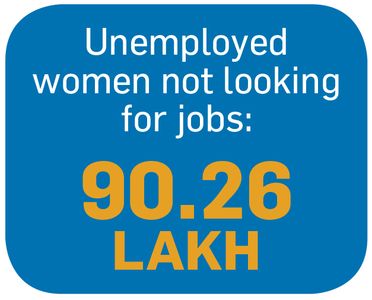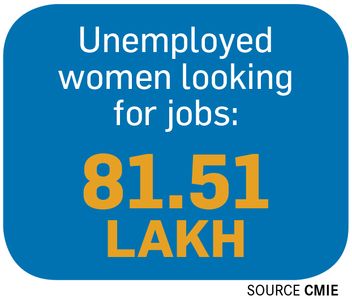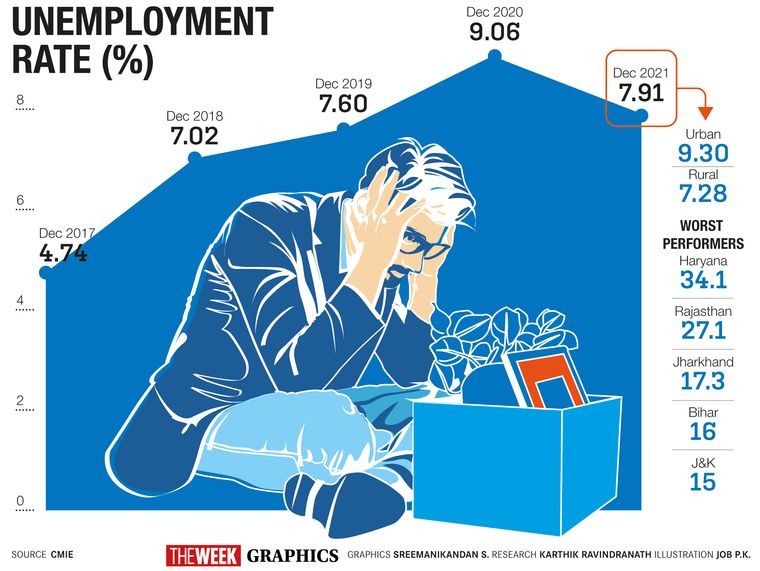Nupur Singh was living her dream before Covid struck. She held a senior position in an event management company which ensured a comfortable life, good salary and opportunities to travel. The pandemic, however, brought her world crashing down and dented her confidence completely.
“I was without a salary for a year. I have always been an independent woman, so I found it hard to ask my husband to pay for me. There were days I would confine myself to my room. All our plans for the future appeared hazy,” said the 45-year-old Noida resident.
Bereft of choices, she was forced to work as a data analyst with an American company. She is now learning coding. “Gone are the days of compulsive shopping. Now, I value money, and look at ways to save more. The lesson I learnt is to have a back-up plan at all times,” she said.
Like Singh, Kritika Kashyap from Delhi, too, found a life saver in an area which thrived despite the pandemic. After losing her job as a stewardess with Lufthansa, she dipped into her savings to go to Rishikesh to train as a yoga instructor. “Everyone is becoming a yoga teacher these days. I am upgrading my skills to study fitness and nutrition, which will help me become an expert,” said Kashyap.
Nitya Sudhakaran from Mumbai faced a prolonged period of distress when her employer, Jet Airways, closed shop. After spending 12 years in the revenue management unit at Jet, she found work in an allied field, but which required a different skill set. “Never be comfortable in one place. Keep upgrading your skills and move around. That is my big learning,” said Sudhakaran.
Highly ambitious and self driven, these career women were forced to move away from the formal economy during the pandemic. With their grit and determination, they have started earning again, but there are lakhs of women who continue to remain unemployed. ‘She-cession’, derived from recession, is the term often used to describe how the failing economy is unkind to women.
The missing women workforce has been captured by several studies. According to the World Economic Forum’s Global Gender Gap Report 2021, India slipped 28 places from its 112th position, to 140. In south Asia, only Pakistan and Afghanistan now fare worse than India.
The gender gap report found that among the drivers of this decline is the substantial decrease in women’s labour force participation rate, which fell from 24.8 per cent to 22.3 per cent. The share of women in professional and technical roles declined to 29.2 per cent. These figures were reaffirmed by the Union ministry of statistics and programme implementation’s first-ever time-use survey.
In India, only 20.6 per cent of women aged between 15 and 59 years are engaged in paid work, compared with 68.5 per cent of men in the same age bracket. In case of unpaid work, 94 per cent of women did so against 49 per cent of men.
Rosa Abraham, assistant professor, Azim Premji University, Bengaluru, who co-authored a report titled ‘State of Working India, 2021’, said the decline has been visible since 1993. “These women are from poor households and are primarily employed in agriculture. They have moved out of jobs that were not good for them as their household income increased. While the women were able to withdraw from bad jobs, there are no new jobs created for them in the economy.”
For every 1 per cent growth in the GDP, the accompanying growth in employment has steadily slowed. “When jobs are rationed, historically, women are the first to get rationed out. Good jobs are not being created. It is an issue that has not been addressed,” said Abraham.
While women may have been at the receiving end of economic upheavals, they remain a decisive force when it comes to exercising their voting rights. Known as silent voters, they rallied behind those governments, be it in Bihar, West Bengal or Assam, whose policies positively impacted their lives. As five states go to the polls, political parties have made promises to women including Rs1,000 per month, free mobile phones, 40 per cent quota in jobs, women-centric manifestos and more tickets to contest.
When Finance Minister Nirmala Sitharaman rises to present the Narendra Modi government’s ninth budget on February 1, one of the key issues to watch out for is whether the government would orient its focus on women jobs and would elevate their participation in the economy. Overall, job creation and inflation have emerged as main concerns for the government, which are turning into key election issues.
As research has shown, young workers are also impacted by the pandemic. Jaipur-based graphic designer Tanvi Parnami was laid off when her online media company could no longer support its employees during the pandemic. “I worked from 7am to 11pm during the pandemic, my company knew that I was good and I thought that I would keep my job,” said the 22-year-old. Still, she lost her job.
She then applied to nearly 150 employers and the only offer she got was from a Bengaluru-based startup. “There were financial issues at home as I was the only earning member,” said Parnami. “My mother, a schoolteacher, was paid just Rs500 a month during the pandemic. My father even started working at a factory after 22 years.”
Things, however, may be finally looking up for youngsters like Parnami as companies are making an effort to recruit young talent, but the situation is far from rosy. “Less than 20 of 100 working age women have economic agency of their own. Among working women, the entrepreneurs were hit hard. The entrepreneur’s job is a 24x7 one. Most of them found it difficult and had to shut shop,” said Madhura Dasgupta Sinha, founder and CEO of the Mumbai-based startup, Aspire for Her. “Our aim is to bring one million women into the workforce by 2025 by building community, education, entrepreneurship and upskilling.”
It is here that Bengaluru-based entrepreneur Farheen Quadri’s experience comes in. She left a high paying corporate job to start Zoey Cafe. When the pandemic hit, she continued to support her staff, despite shutting down one of her units. “I knew I had to go on. I loved cooking. So I decided to shift to cooking for those who fasted during Ramzan. Orders started pouring in. Soon, people started placing bigger orders on seeing my enthusiasm,” said Quadri.
While the women in the formal sector are vocal about their needs, it is those in the informal sector, which constitute over 90 per cent of the country’s workforce, that suffer the most. “My two surveys among women in Delhi revealed how they faced hardship and higher mental stress during the pandemic,” said Shiney Chakraborty of the Delhi-based Institute of Social Studies Trust. “Among them are people who run their business from home, street vendors, construction workers and domestic helps. They had to take loans at very high interest rates to sustain themselves.”
While the Central government has stepped in with schemes like Pradhan Mantri Ujjwala Yojana and Swachh Bharat and offered enhanced maternity benefits and upskilling training for women, the implementation of most schemes has not been up to the mark. Chakraborty said schemes like the Ujjwala Yojana were marred by the rising costs. “Most women told me that they switched to LPG as the first cylinder was free, but paying for new cylinders was not possible for most of them.”
While women look at Sitharaman with hope, the options before the finance minister are rather limited. While several positive indicators point to an economic recovery, many sectors continue to suffer. India Ratings and Research Pvt Ltd expects the economy to grow by 7.6 per cent in 2022-23, a meaningful expansion after two years. The bigger challenges, however, are job growth and inflation.
“There are challenges in the MSME (micro, small and medium enterprises) and the informal sector. We informed the finance minister about the issues as the rising commodity costs have impacted MSMEs. There are issues of credit requirement and working capital NPAs for the MSMEs,” said Gopal Krishna Agarwal, the BJP’s expert on economic affairs.
The Central government looks at filling the employment gap by increasing spending on infrastructure. But the gap is huge. According to a report by the Centre for Monitoring Indian Economy (CMIE), as of December 2021, there are still over 35 million people who are not employed and are actively looking for jobs. Another 17 million unemployed are not actively looking for work, but are willing to work if there are suitable jobs.
According to the CMIE, of the 35 million unemployed who are actively looking for work, 23 per cent are women. The corresponding figure among the 17 million passively unemployed is 53 per cent. “It is worth investigating why such a large number of women who tell interviewers that they are willing to work are not actively applying for work or making other efforts in finding work,” said CMIE CEO Mahesh Vyas in his report.
Abraham said although the workforce participation rate may have returned to pre-pandemic levels, there was a change in the nature of the workforce. A lot of new women have entered the workforce, especially those from distressed households. “We have also found that those who have lost jobs are daily wagers and unskilled labourers. But those who are likely to return are men who had more experience. If you have education, you are likely to get work. But for women, the recovery is agnostic of their experience or education.”
Politically, job creation remains Sitharaman’s biggest challenge. The government’s push for higher spending and capex can further raise the fiscal deficit. With India being in the third wave of the pandemic, it has been a cause of concern. Anubhuti Sahai, head (South Asia), economics research, Standard Chartered Bank, said Omicron had only a limited impact on the economy. Sahai said, “Tighter global conditions will have an impact on India, but the budget will be formulated based on the domestic macroeconomic conditions. We would hope that there are certain steps for targeted sectors, like contact intensive sectors where recovery has been delayed.”
Sahai said the finance minister needed to ensure enough expenditure thrust to keep the growth momentum supported. She also called for fiscal consolidation if the government wanted to be included in major global bonding indices. “Fiscal deficit will have a direct impact on the interest rates and, therefore, on economic recovery,” Sahai said. “The finance minister is likely to strike a fine balance, with a target of 6 per cent in the next fiscal.”
Experts expect that the budget will have to keep in mind the fiscal condition, but should still have steps to ease the situation for the poor, women, youth, middle class and the marginalised.
While many economists pitch for fiscal consolidation to bring the deficit down to 6 per cent, Agarwal said fiscal consolidation should not be steep in the medium term as it would impact expenditure to boost growth. “The government should give a roadmap for fiscal consolidation on what can be done in the next two years to boost investors’ sentiment,” he said.
Agarwal also called for some changes in direct taxes to put more money in people’s hands. The BJP has asked Sitharaman to devise a mechanism by which money can be transferred directly into the accounts of beneficiaries of Central schemes that are blocked by certain states.
To address the jobs crisis, Chakraborty wanted the government to extend job guarantee schemes like the Mahatma Gandhi National Rural Employment Guarantee Act in urban areas, with reservation for women. Other government schemes like the Mudra loans, too, can be fine-tuned to extend further benefits for women.
Abraham, meanwhile, said the government should continue its scheme of contributing to the employees’ provident fund, especially for women, to incentivise companies to hire more women, and also bring some kind of wage subsidy for young workers without jobs. Two sets of graduates have passed out in the last two years, but they are without any relevant experience. The government should bring an apprenticeship scheme and even conduct bridge courses to upgrade their skills to keep them relevant.
For Sitharaman, the challenge may just be beginning with the new budget.





